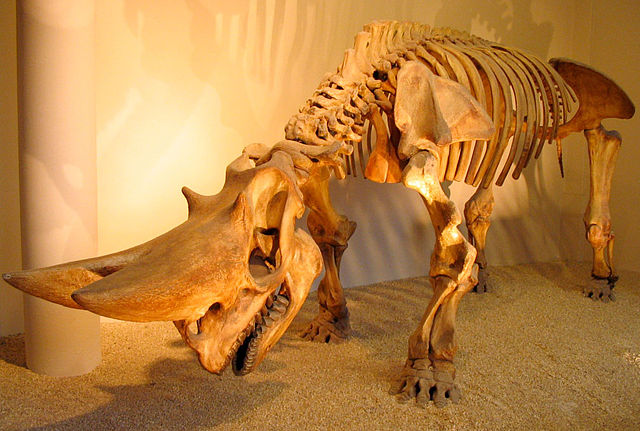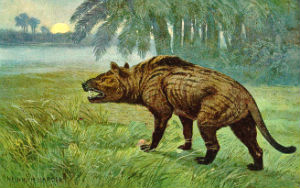Fayum
The Jebel Qatrani
Online Biology Dictionary
 Arsinoitherium zitteli (Fayum, early Oligocene, Natural History Museum, London). Image: Wikimedia
Arsinoitherium zitteli (Fayum, early Oligocene, Natural History Museum, London). Image: Wikimedia
|
|
The Fayum, or Jebel Qatrani, Formation is a geological formation located in northeastern Egypt. It is exposed between the Jebel Qatrani and the Qasr el Sagha escarpments north of Birket Qarun Lake (anciently known as Lake Moeris). Its rocks were long thought to lie entirely within the Oligocene. However, it is now generally believed to include the Eocene-Oligocene boundary, which dates to 34.9 million years ago. The formation is composed primarily of sandstone deposited by slow rivers and seasonal lakes.
 Hyaenodon, an extinct creodont. Artist: Heinrich Harder
Hyaenodon, an extinct creodont. Artist: Heinrich Harder
Its Eocene strata preserve the traces of a diverse woodland fauna, including pig-like anthracotheres, large hyraxes, and hyena-like creodonts. Present, too, was an early, tiny primate Aegyptopithecus. But fossils preserved in the lower portion of the Oligocene strata are the remains of organisms that lived in a drier savanna environment that replaced the forests for millions years before the region turned wet once again and the woodlands returned, as reflected in the uppermost portion of the formation.
 Arsinoitherium. The Jebel Qatrani Formation is the only site where complete skeletons of this animal have been found. Artist: Heinrich Harder
Arsinoitherium. The Jebel Qatrani Formation is the only site where complete skeletons of this animal have been found. Artist: Heinrich Harder
 Aye-aye
Aye-aye
Also found, in 1992 near the base of the formation (quarry L-41), was the skull of a strange primate, Plesiopithecus, having cranial and dental traits similar to those of the extant Aye-aye (Daubentonia), which is now restricted to Madagascar (see image at right). Scientists are still puzzling over the relationships of this animal, because Madagascar has been isolated by open ocean from mainland Africa for 100 million years, and most researchers do not believe the Aye-aye could have existed prior to that date (this is yet another fact consistent with stabilization theory's account of mammalian origins given elsewhere on this website). Conventional theory describes mammals as having radiated from a common ancestor that lived at the time of the extinction of the dinosaurs some 70 million years ago. Which means that the existence of an aye-aye in Egypt 40 million years ago, together with the present existence of aye-ayes in Madagascar suggests that these animals must have either dispersed over open ocean (after coming into being either in Africa or on Madagascar) or that they came into being before Madagascar became isolated, prior to 100 mya. But the latter option would mean they would have existed at least 30 million years too early to satisfy standard theory. Quite a discrepancy.
So what can any conventionally minded biologist say about an aye-aye's presence in Egypt at such an early date? — Except perhaps, "An Aye-aye?!? Aye Yai Yai!!!"
Most shared on Macroevolution.net:
Human Origins: Are we hybrids?
On the Origins of New Forms of Life
Mammalian Hybrids
Cat-rabbit Hybrids: Fact or fiction?
Famous Biologists
Dog-cow Hybrids
Georges Cuvier: A Biography
Prothero: A Rebuttal
Branches of Biology
Dog-fox Hybrids
